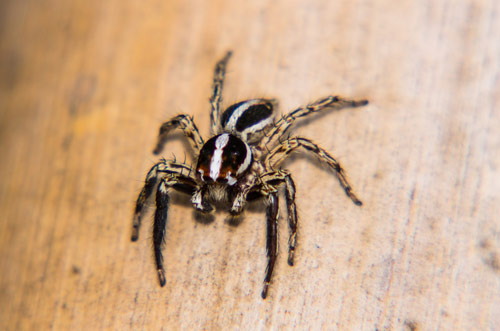
Fun facts that may or may not make spiders seem less creepy.
We came across this great article that helps take a little of the fear factor off of spiders on PestWorld.org and we wanted to share it with you!
Spiders have adapted to live in nearly every type of habitat, and they are one of the top 10 most diverse populations on earth. They play vital roles in all ecosystems -except in your home.

The following spider facts will help you learn more about these eight-legged pests, some of which might appear in your backyard this summer and fall.
All spiders produce silk
Something common to all 40,000 species of spiders is that they all spin silk. And as spiders have evolved, so has their ability to work with silk. One spider can produce up to seven different types, each used for a different purpose such as spinning webs or capturing prey.
One species is mostly vegetarian
It was thought that all spiders were carnivorous, capturing and eating other insects, but one species in Central America has been found to be mostly herbivorous! Bagheera kiplingi inhabit trees that produce protein-rich buds on their leaves. These buds are part of a symbiotic relationship between the trees and ants, but B. kiplingi also benefit from consuming the buds. However, during dry seasons these spiders are known to be carnivorous. They may cannibalize each other or steal ant larvae when food is scarce.
Spiders are nearsighted
Most spiders have eight eyes, but some, like the brown recluse spider, only have six. Spiders typically have a main set that can create images while the secondary sets can only detect light and shadow. It is thought that the secondary sets of eyes are derived from the compound eyes of a common ancestor to both spiders and insects.
But even with all of those eyes, spiders cannot see far into the distance. Nearsightedness is a problem for people, but the habits of spiders are such that being nearsighted isn’t a deficiency. They wait for prey to get caught in their webs and use silk trip wires to warn of approaching predators.
Females can lay up to 3,000 eggs at one time
These eggs are housed in one or more silk sacs. The level of care a female spider provides for her young varies by species. Some females will die shortly after laying eggs while others will carry spiderlings on their backs or share prey with them.
Jumping spiders can jump up to 50x their own length
When hunting or trying to escape a predator, jumping spiders are able to make very agile movements and jump multiple times their body length. This is possible due to an internal hydraulic system. Jumping spiders can alter the pressure of fluids in their legs resulting in a springing motion that propels the spiders forward.
The ‘daddy long-legs’ you see might not actually be a spider
The nickname ‘daddy long-legs’ has been given to several different pests, only one of which is an actual spider. Crane flies, harvestmen and cellar spiders are all colloquially identified as ‘daddy long-legs.’ Only cellar spiders are spiders. Harvestmen are in the arachnid family, but they lack venom and silk glands. Crane flies are agricultural pests with very long legs and the ability to fly.
If you think you have a spider infestation in your home, contact a licensed pest professional to identify the species and recommend steps for removal or treatment. Some species are poisonous to humans and should be handled by a professional.
To learn more about the different types of spiders found in the United States, read our Spiders 101 article.
Remember that spiders do lay up to 3,000 eggs at a time and if you are finding quite a few spiders inside your house it may be time to treat before the rest of them start showing up and infesting your house.
Also if that article didn’t make you feel any better and you want help treating your house to keep out those creepy spiders we would be happy to help!